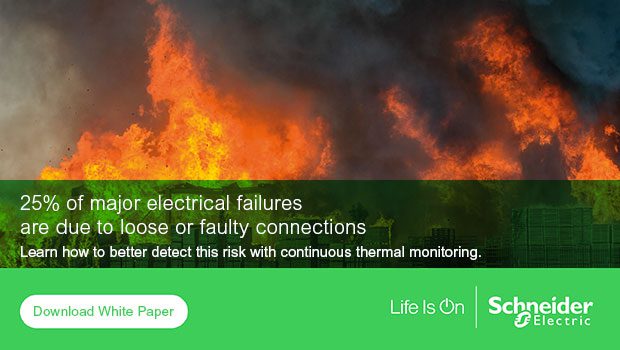We all know how potentially devastating electrical fires can be in any building. Not only is human life put at risk, but also the resulting property damage and business disruption can be extremely costly. Take, for example, the fire caused by a switchgear failure at Atlanta’s Hartsfield Airport in 2017, which caused US$50 million in losses and 1,400 canceled flights for Delta Airlines.
Electrical fires account for 22% of workplace fires and are among the top causes of fires in hospitals (after cooking-related incidents). While the electrical fires are often due to defects in medium or low voltage system wiring, switches, and motors, one major insurance carrier estimates approximately 25% of all major electrical failures are due to loose or faulty connections.
This is why many regulatory bodies require annual thermal surveys to reduce fire risks due to faulty connections. Up to now, infrared (IR) thermography has been the method used for these surveys. The method can be very effective when done in compliance with regulations. In this two-post series, we’ll look at how electrical fires happen and how emerging continuous thermal monitoring solutions now offer a safer and more comprehensive way to detect thermal risks.
What starts an electrical fire?
Faulty electrical connections are a major cause of failure in MV and LV installations. Improper tightening torque, constant vibrations, corrosion, or excessive pressure or friction can cause cable, busbar, and circuit breaker connections to deteriorate. Frequent temperature cycling and on/off switching can contribute further to loosening.
Service malpractices can also cause problems. Any errors in inspection, retightening, or alignment during cable insulation testing or maintenance on circuit breakers can result in an unreliable connection point.
For such connections, increasing contact resistance accelerates deterioration which, in turn, causes an increase in temperature. This causes more deterioration, more resistance, and eventual thermal runaway causing a fire, flashover, or explosion. This is why it’s essential to catch abnormal busbar temperature rises early enough to prevent fires.
Potential weaknesses of thermal inspections
The most common approach for thermal inspections is using IR thermography, a thermal camera to inspect the highest-risk areas of electrical equipment. This is usually done at regular intervals, for example, every 12 months. Though the technology and process are effective when performed within these parameters, the method has a few potential weaknesses.
First, as inspections are only performed at specific intervals, staff might not be alerted to the fast deterioration of a particular connection point. Restricted access to some electrical rooms may cause even more risks to be missed.
Next, for testing of live equipment, an IR window is often installed in a switchgear door to enable camera access, or the operator might need to open a door for access to LV equipment. Limited space and visibility of contact points can also challenge camera positioning. These conditions can raise safety concerns regarding the risk of exposure to arc flash.
Finally, IR thermography surveys can be costly, though the return-on-investment is high. It’s been estimated that IR inspections followed by timely repairs can deliver a 4:1 payback to avoid equipment failures.
In my next post, we’ll look at how new thermal monitoring systems deliver several maintenance and operational advantages over IR thermography, with an even greater ROI.
To learn more about thermal monitoring solutions, download the Schneider Electric white paper “Beyond IR thermography: how continuous thermal monitoring improves performance and equipment protection” and view our video below.
Editor’s Note: This post was originally published on November 8, 2018 and has been recently updated for accuracy and comprehensiveness.




